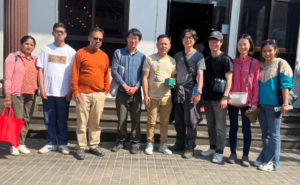Intergenerational Impact of Female Community Health Volunteers: A Mixed Method Study
in Far-Western Nepal.
Summary:
Initiated in 1988, the Female Community Health Volunteers (FCHVs) program was designed to
bolster Nepal’s primary healthcare network and enhance community participation. Over the past
four decades, these volunteers have become a cornerstone of rural health, contributing significantly
to the use of modern health services, and reducing morbidity and mortality rates. Despite their
contributions, a critical evidence gap exists, particularly concerning the long-term health impact
of FCHVs. Existing studies have predominantly focused on short-term outcomes, leaving a void
in our understanding of the sustained effects of the FCHVs program.  This study seeks to bridge
This study seeks to bridge
this gap through a pilot study that harmonizes the strengths of quantitative and qualitative methods.
We aim to estimate the causal impact of FCHVs on maternal and child health outcomes while
simultaneously utilizing qualitative reasoning based on everyday experiences and perceptions of
FCHVs.
We propose a mixed-method approach with an embedded design, where the quantitative findings
are backed up by qualitative insights. The quantitative component utilizes a quasi-experimental
design within the instrumental variable framework. Concurrently, the qualitative component
adopts a case study design, offering an in-depth exploration of FCHVs’ subjective perspectives
and experiences. This approach is especially pertinent for a pilot study assessing the feasibility of
the instrumental variable approach, given the nationwide, non-random implementation of the
FCHVs program.
The study will be conducted in selected districts from Lumbini, Karnali and Sudurpachim
provinces, representing the essence of far-western Nepal—a region grappling with economic
hardships and vulnerability to natural calamities. The three provinces presents a diverse landscape,
enabling an understanding of urbanand rural areas across mountain, hilly and Terai regions. For
the quantitative phase, eighty urban and rural wards from the three provinces will be identified
using probability proportionate to population size, and within these wards, 2000 households will
be randomly chosen through systematic sampling. The research process begins with interviews of
FCHVs in the selected wards, preparing a sampling frame for the household survey within their
catchment areas. Trained enumerators will collect quantitative data using the ODK app, facilitating
causal impact estimation through two-stage least square estimation. Concurrently, a focused group
discussion with approximately nine FCHVs from the selected wards will be conducted during a
two-day orientation program. Qualitative data will undergo transcription, translation, and thematic
analysis.
This study holds crucial implications within Nepal’s health system landscape by focusing on the
long-term impact of the FCHVs program. Through a mixed-method approach, specifically
employing an instrumental variable framework, we aim to provide in-depth insights into the
intergenerational dynamics of FCHVs spanning over 40 years. This research not only addresses a
significant evidence gap but also contributes methodological advancements to public health
research, particularly emphasizing the feasibility of utilizing an instrumental variable approach in
assessing the impact of national programs implemented on blanket approach. The findings are
poised to offer nuanced recommendations for shaping policies and interventions that consider the
1diverse contributions and experiences of different FCHV generations, ensuring the sustained
success of community health initiatives in Nepal.
Background:
The FCHVs program in Nepal, initiated in 1988 by the Ministry of Health and Population
(MOHP), represents a pivotal component of the country’s primary healthcare strategy [1, 2].
Designed to strengthen the primary healthcare network, foster community participation, and
extend the reach of health services, FCHVs serve as a vital link between the government and local
communities [3].
Initially conceived with a focus on health promotion and education, the role of FCHVs has evolved
over the years. While their primary responsibilities continue to centre around health education,
FCHVs have also taken on tasks related to the treatment and administration of preventive
commodities [3, 4]. In the mid-1990s, the program witnessed an expansion with additional FCHVs
recruited across 28 districts based on population ratios. Furthermore, recruitment in urban areas
has increased the current carder to over 52,000 FCHVs [1, 2].
Since their inception, FCHVs have significantly contributed to transforming healthcare outcomes
in rural Nepal. Their multidimensional contributions include increasing the utilization of modern
health services, reducing infant, child, and maternal mortality rates, and ensuring the prevention
and treatment of prevalent diseases [5-7]. Currently, FCHVs play a crucial role in maternal and
child health, providing services such as health and nutrition counselling, immunization,
dissemination of pregnancy-related information, and family planning services. Furthermore, they
serve as vital sources of basic health information, particularly on emerging non-communicable
diseases affecting women in Nepal [8-11].
While the effectiveness of FCHVs activities has undergone assessments in the past, existing
evidence is not contemporaneous and fails to capture the long-term health impact. The term
“intergeneration” in our study is contextualized within the multi-generational span of the FCHVs
program, operationalized to encompass diverse recruitment cohorts of FCHVs actively engaged
since its inception in 1988. It refers to FCHVs serving continuously since recruitment and those
succeeded by second or third generations. By collecting data from FCHVs representing different
recruitment periods, we intend to explore how the various recruitment cohorts and the succession
of FCHVs influence health outcomes for under-five children. This approach allows us to assess
the evolving impact of the FCHVs program on maternal and child health outcomes over time,
recognizing the potential intergenerational transfer of knowledge and practices within the program.
Our study aims to contribute to the existing knowledge base, informing policy and practice for the
continued enhancement of community health initiatives in Nepal.
Rationale/Justification:
The FCHVs program in Nepal has spanned over four decades, embedding itself deeply in Nepali
communities. As the nation undergoes health system restructuring amid federalism and grapples
with the aftermath of the COVID-19 pandemic, evaluating the long-term health impact of the
FCHVs program becomes crucial. This study contributes insights into FCHV activities amidst
evolving health priorities, supporting ongoing discourse on health system strengthening and
resilience. The study also addresses a significant knowledge gap concerning the long-term
2intergenerational health impact of FCHVs, aiming to provide valuable insights for informed public
health decision-making. Moreover, the study holds relevance in monitoring the achievement of
health-related Sustainable Development Goals (SDGs). In alignment with global aspirations, this
research considers the FCHVs’ contribution to specific health-related SDGs. By scrutinizing the
program’s outcomes through the lens of these internationally recognized goals, the study offers a
nuanced understanding of its impact on crucial areas such as maternal and child health. It
supplements the monitoring process, facilitating progress measurement and informing policy
interventions, thereby supporting Nepal’s broader sustainable development objectives.
General Objective:
This study aims to explore the inter-generational impact of FCHVs on maternal and child health
outcomes through quantitative causal impact assessment and qualitative analysis of their everyday
experiences.
Specific Objectives:
• To systematically collect quantitative data from sample households within the selected
urban and rural wards of Lumbini, Karnali and Sudurpachin proviences, utilizing
standardized instrument and survey methods.
• To gather qualitative data from FCHVs within the selected wards, emphasizing their in-
depth insights into their roles and their perception of health outcomes in the community
they serve.
• To estimate the short- and long-term health impacts of FCHVs activities using two stages
least quate estimation within the framework of instrumental variable approach and
triangulate the estimated results with the available qualitative evidence.
• To disseminate the study findings effectively through peer-reviewed publications and
workshop presentations.
